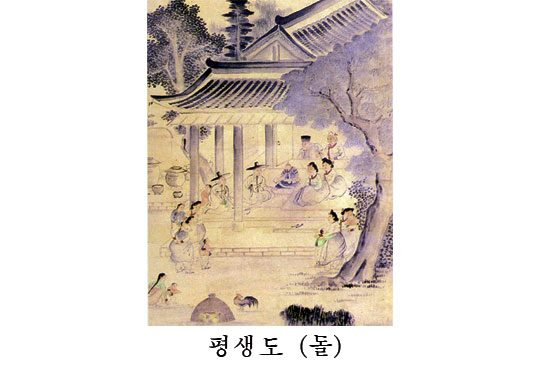Custom of celebrating the first birthday of a child
The custom refers to the ceremony of celebrating the first birthday of a child.
In Korea there is a custom of celebrating the first birthday of a child as an important event.
According to the history book Jibongryusol, a child was attired in new clothes on the first birthday.
Until the last period of the feudal Joson dynasty, the ceremony followed procedure of having a child attired in a first birthday dress, preparing a table in celebration of a child’s first birthday, letting a child select his or her preference from among the first birthday presents and making a present in return.
The dress for the first birthday of a boy included jogori (Korean jacket) with multi-coloured sleeves, phungchabaji (Korean children’s trousers), magoja (Korean jacket) or turumagi (Korean overcoat), jonbok (Korean coat without sleeves), pokgon (Korean cap), tharaeboson (Korean children’s quilted socks with decoration), toltti (a long belt attached to the children’s coat). The dress for a girl included jogori with multi-coloured sleeves, chima (Korean skirt), paji (tansokgot-Korean underskirt), khun-jogori (outer jacket) with multi-coloured sleeves (magoja), paeja (Korean waistcoat), kule (Korean cap) or jobawi (Korean cap), tharaeboson (Korean children’s quilted socks with decoration) and shoes etc.
It is common in the dress of both boy and girl to put on a long toltti around one’s chest. It reflected the wish for the child’s long life.
Main dishes on the table were rice-cakes and fruits. There were also some goods to be selected on the table.
Generally, a bow and an arrow, noodle, thread, book, rice, rice-cake and the like were put on the table for the selection. The child selected one of the goods on the table and people predicted the talent and future of the child and it was the most interesting event in the celebration.
On this day, they served their relatives and neighbours with some foods and handed round the rice-cakes to the villagers. The villagers made presents of essential goods to the child in return.
The custom reflects not only the love and attempt of our people to bring up their children excellent but also the good manners and customs of living in harmony with neighbours helping each other.
Dr. Ri Sun Hui, Researcher of Korean Folklore Museum
